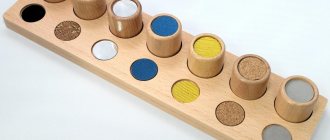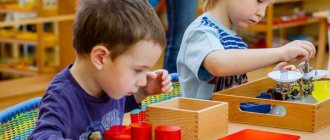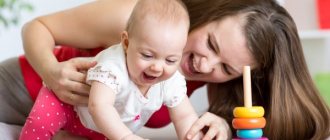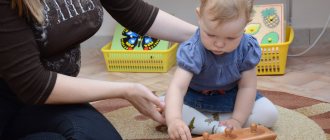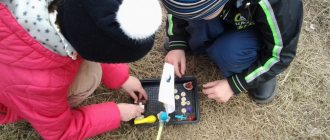For 2.5 years now, my daughter and I have been adherents of the Montessori method - a wonderful early development system that has conquered the whole world, a system based on the idea of free education and deep respect for the interests of the child. I will not repeat myself and talk about the basic principles of the methodology; they were previously written about here. In this article I would like to dwell on how to implement the Montessori method at home. After all, going to a developing Montessori club is one thing, but maintaining the spirit of free education at home is completely different, perhaps this is an even more important component.
You may have already read my article on the website about implementing the Montessori method at home. Now before you is a revised version of the article, written taking into account our accumulated experience in applying the methodology.
So, if you want your child to develop harmoniously, learn to play independently, and at the same time enjoy playing not only with flying fairies and cars, but also with educational educational toys, so that he learns to clean up after himself, then you simply need, firstly, create a developmental environment , and secondly, give the child complete freedom of action in this environment.
And here's what you need for this:
Age-appropriate educational materials
The experience of Maria Montessori showed that children are most interested in those activities and objects that are connected with the real life of adults. Therefore, the children's environment should replicate the adult one: let the children's room have dishes, all kinds of jars, boxes, provide the child with everything necessary so that he can pour water, string beads, cut paper, wipe off dust, etc. The Montessori system places great importance on the development of fine motor skills, so don’t forget about playing with beads, buttons, tweezers, clothespins, etc.
I write in detail about what games will be interesting to a child at each stage of development in the sections “Development of fine and gross motor skills” and “Ready lesson programs.”
Interaction with other children
All toys and objects in playrooms for the development of children 1-2 years old according to Montessori are presented in one copy. This is done intentionally so that small members of society learn to negotiate with each other. Teachers and parents help them with this.
Teachers explain to moms and dads how to react correctly if the baby is capricious and takes toys from other children.
Proper storage for toys
Very often, in children's rooms, all toys are stored in containers or deep toy baskets. In essence, this is a toy dump where it is almost impossible to find anything specific. Yes, a small child will never do this, he simply forgets about those toys that are lying at the bottom of the basket.
In a properly organized play space, all materials are arranged on racks and shelves. At the same time, all the shelves are located at the child’s level so that he can independently take any benefit that interests him. Each material has its own specific place here, which means the child always knows where to get what he needs and where to put it away later.
In Montessori development centers, the play space usually looks something like this:
However, it is very difficult to do something similar in an ordinary city apartment, because all these shelves require a lot of space, and you also need to put a closet somewhere and a bed... Therefore, at home you can make a more simplified version with fewer shelves . In addition, you do not need to post all the manuals at once, as in a development center; you can post a limited number of toys and rotate them regularly. This approach will not only save space in the room, but also help maintain the child’s interest in toys; they will not become boring. More on this below.
Thus, to organize a Montessori environment at home, one 2-3-tier rack is quite enough. It can be made to order or use ready-made solutions. We bought our rack at an Ikea store, this is what it looked like at 2 years old:
When such a shelving unit appeared in our nursery, it immediately became clear that this was a huge boon! I’m not talking about my daughter’s delight at all. Previously, frame inserts, knockers and other equipment were lying on the windowsill, where everyone always forgot about them, now everything was in plain sight, both for my daughter and for me. When Taisiya started playing, it was immediately clear what to tackle
There are several important points that you need to know in order to organize a competent Montessori environment in which your child will always be interested.
1. There shouldn’t be a lot of toys on the rack!
Firstly, a limited set of toys makes it easier for the child to choose and helps him concentrate on something specific. Secondly, if the shelves are chock full of developmental materials, then getting to any specific one becomes not so easy. Well, if a child experiences difficulties associated with pulling out and putting away the material, then with a high degree of probability he will prefer not to play with it at all.
2. It is necessary to constantly change the toys displayed on the rack.
When I first organized a shelving unit for my daughter, I was guided by the display of the development club - absolutely all the developmental materials available were laid out there. I wanted Taisiya to have a full selection of materials at home, so I pushed into the rack all the educational toys we had that were currently suitable for my daughter’s age. Some time passed before I realized that my daughter simply stopped noticing the toys that were constantly in the rack! They became so familiar to her that they seemed completely uninteresting.
Then I did what should have been done from the very beginning: I put all the toys in a closed cabinet, and put only a limited set of materials on the shelves so that each one was clearly visible. Every week I began to conduct a small audit: I removed from sight those toys in which there was no interest, and replaced them with others. And here the second life of our Montessori shelving began! Materials that no one had looked at before began to sparkle with new colors.
Regular rotation of toys is really very important, it helps to maintain the child's constant interest in developmental aids. It also allows you to get by with a small set of toys, since, disappearing from the child’s field of vision, they are soon perceived as a new thing.
Naturally, in order to meet the baby’s changing interests and promote his further development, completely new materials need to be displayed from time to time.
3. Toys should be at a height accessible to the child
(no higher than eye level), so that he can take from the shelf and put back any benefit that interests him without the help of an adult.
4. Each item on the rack should have its own place.
If possible, place toys so that they are visually separated from each other (at a short distance from each other).
5. The rack must be open.
Avoid anything that blocks the child’s view of the contents of the shelves: a large number of drawers, doors, etc.
Maria Montessori recommends distributing all materials into zones. In your shelving, you can also group games by meaning. For example, in one compartment you can always lay out insert frames, in another - cubes and construction sets, in the third - lacing, fasteners,
in the fourth - puzzles,
in the fifth - musical instruments, etc.
Despite the fact that Maria Montessori paid little attention to role-playing play, I am convinced that role-playing toys are also necessary on the shelf. For us, these sections have always been one of the most used.
Organization of lessons
The Montessori method involves 3 types of activities.
- Individual. The teacher offers educational material to one or 2-3 children and demonstrates, without lengthy explanations, the possibilities of its use. Such material should arouse interest in the baby, have some bright distinctive property, and make it possible to check whether it performed the action correctly. Then the child or children work with the material independently. When conducting such a lesson, the teacher’s other children do not ask for anything.
- Group. They involve children who have reached approximately the same level of development. The lesson plan is similar to the previous one. The rest of the children in the class study without a teacher.
- Are common. The whole class participates in these lessons. These are classes in general subjects - history, music, gymnastics. Such lessons are usually short, and then the children again decide for themselves what and where to do.
Studying according to this system, children move from one class to another. But when they should do this is determined by the capabilities of a particular child. That is, this is a technique applicable to both younger and older ages. In such classes there are no specific goals for each year; children study at their own pace. One of the main rules here is not to disturb others. That is, behave quietly, do not take away benefits, do not interfere with someone who is studying alone in some area, and be able to properly build relationships with other children.
Furniture and play equipment according to the child’s height
To prevent your baby from feeling like a midget in the land of giants, it is advisable to purchase furniture for him according to his height. A children's table and chair are primarily needed to ensure that the baby sits in the correct position during creative activities, and also to ensure that the child has the opportunity to independently prepare his/her own work space (bring paints, brushes). A children's easel and magnetic board will also be very useful.
How do classes on the development of children 1-2 years old take place in groups?
In specialized centers where classes are conducted according to the Montessori system, groups of children are recruited by age. The little ones, those who are barely one year old, are also trained. They are formed into small groups (5-10 people). The main question for parents when welcoming a baby is not how many full months he is, but how confidently he can walk. After all, the development of a 1-2 year old child according to the Montessori system implies giving him complete freedom in choosing an activity.
The equipment of play areas in development centers corresponds to the growth of children. All aids are positioned so that the baby can pick them up and then put them back in place.
Personalized cleaning products for your baby
An integral part of the Montessori system is providing the child with the opportunity to clean up after himself. Give your child a cloth, a sponge, a small mop, a brush and a dustpan for his own use so that he can clean up spilled grain or spilled water during play. Let cleaning products always be in a place specially designated for them. There must be a trash basket in the baby's room.
Creative corner
Very often, paints, plasticine, and glue are stored in drawers and other places inaccessible to children. A child draws only when his mother suggests, and not when he wants it. However, it is very important to provide the child with the opportunity for spontaneous creativity.
Try to organize a creative corner for your child so that the same rules about accessibility, limited availability and regular updating of materials are observed.
This could be a creative table in a place convenient for the child or a shelf on your shelf reserved for creative materials. Do not post a lot of different materials there at once; it would be better if they are updated regularly.
Naturally, if the child is still too young, tastes almost everything and does not yet know the rules for working with certain materials, you should not put glue, sharp scissors or liquid paints in the public domain. But you can already put a stack of paper and a few wax crayons.
How did the Montessori method come about?
Maria Montessori is a doctor and teacher from Italy. At the beginning of the 20th century, she worked a lot with children, creating programs for students with mental disabilities.
She managed to become the director of the Orthophrenic Institute and a teacher at a local school. The wards demonstrated impressive results, passing exams together with absolutely healthy people.
Montessori used her extensive experience to create her own method of early childhood development, which quickly became popular in European countries. In the USSR, the system did not take root for political reasons: totalitarianism and free thinking are incompatible. The Montessori method began to be introduced only in the 90s.
Over the course of a century, teachers have become convinced that the method has a beneficial effect on the child’s psyche, reveals potential and helps to quickly absorb knowledge. Even members of the British royal family studied Montessori.

